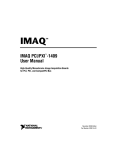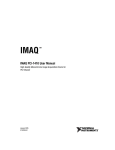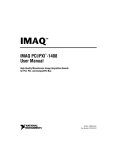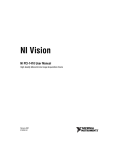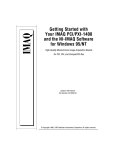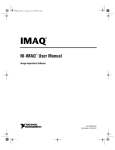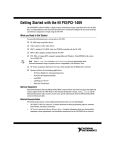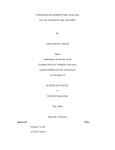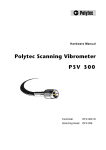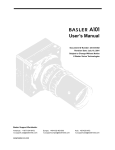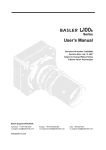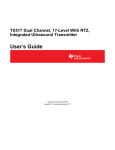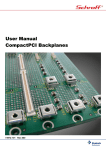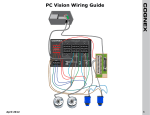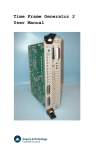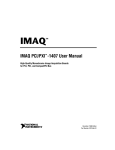Download NI PXI/PCI-1409 User Manual
Transcript
NI Vision NI PXI/PCI-1409 User Manual High-Quality Monochrome Image Acquisition Device NI PXI/PCI-1409 User Manual February 2007 372811C-01 Support Worldwide Technical Support and Product Information ni.com National Instruments Corporate Headquarters 11500 North Mopac Expressway Austin, Texas 78759-3504 USA Tel: 512 683 0100 Worldwide Offices Australia 1800 300 800, Austria 43 0 662 45 79 90 0, Belgium 32 0 2 757 00 20, Brazil 55 11 3262 3599, Canada 800 433 3488, China 86 21 6555 7838, Czech Republic 420 224 235 774, Denmark 45 45 76 26 00, Finland 385 0 9 725 725 11, France 33 0 1 48 14 24 24, Germany 49 0 89 741 31 30, India 91 80 41190000, Israel 972 0 3 6393737, Italy 39 02 413091, Japan 81 3 5472 2970, Korea 82 02 3451 3400, Lebanon 961 0 1 33 28 28, Malaysia 1800 887710, Mexico 01 800 010 0793, Netherlands 31 0 348 433 466, New Zealand 0800 553 322, Norway 47 0 66 90 76 60, Poland 48 22 3390150, Portugal 351 210 311 210, Russia 7 495 783 68 51, Singapore 1800 226 5886, Slovenia 386 3 425 42 00, South Africa 27 0 11 805 8197, Spain 34 91 640 0085, Sweden 46 0 8 587 895 00, Switzerland 41 56 200 51 51, Taiwan 886 02 2377 2222, Thailand 662 278 6777, Turkey 90 212 279 3031, United Kingdom 44 0 1635 523545 For further support information, refer to the Technical Support and Professional Services appendix. To comment on National Instruments documentation, refer to the National Instruments Web site at ni.com/info and enter the info code feedback. © 2000–2007 National Instruments Corporation. All rights reserved. Important Information Warranty The NI PXI/PCI-1409 is warranted against defects in materials and workmanship for a period of one year from the date of shipment, as evidenced by receipts or other documentation. National Instruments will, at its option, repair or replace equipment that proves to be defective during the warranty period. This warranty includes parts and labor. The media on which you receive National Instruments software are warranted not to fail to execute programming instructions, due to defects in materials and workmanship, for a period of 90 days from date of shipment, as evidenced by receipts or other documentation. National Instruments will, at its option, repair or replace software media that do not execute programming instructions if National Instruments receives notice of such defects during the warranty period. National Instruments does not warrant that the operation of the software shall be uninterrupted or error free. A Return Material Authorization (RMA) number must be obtained from the factory and clearly marked on the outside of the package before any equipment will be accepted for warranty work. National Instruments will pay the shipping costs of returning to the owner parts which are covered by warranty. National Instruments believes that the information in this document is accurate. The document has been carefully reviewed for technical accuracy. In the event that technical or typographical errors exist, National Instruments reserves the right to make changes to subsequent editions of this document without prior notice to holders of this edition. The reader should consult National Instruments if errors are suspected. In no event shall National Instruments be liable for any damages arising out of or related to this document or the information contained in it. EXCEPT AS SPECIFIED HEREIN, NATIONAL INSTRUMENTS MAKES NO WARRANTIES, EXPRESS OR IMPLIED, AND SPECIFICALLY DISCLAIMS ANY WARRANTY OF MERCHANTABILITY OR FITNESS FOR A PARTICULAR PURPOSE. CUSTOMER’S RIGHT TO RECOVER DAMAGES CAUSED BY FAULT OR NEGLIGENCE ON THE PART OF NATIONAL INSTRUMENTS SHALL BE LIMITED TO THE AMOUNT THERETOFORE PAID BY THE CUSTOMER. NATIONAL INSTRUMENTS WILL NOT BE LIABLE FOR DAMAGES RESULTING FROM LOSS OF DATA, PROFITS, USE OF PRODUCTS, OR INCIDENTAL OR CONSEQUENTIAL DAMAGES, EVEN IF ADVISED OF THE POSSIBILITY THEREOF. This limitation of the liability of National Instruments will apply regardless of the form of action, whether in contract or tort, including negligence. Any action against National Instruments must be brought within one year after the cause of action accrues. National Instruments shall not be liable for any delay in performance due to causes beyond its reasonable control. The warranty provided herein does not cover damages, defects, malfunctions, or service failures caused by owner’s failure to follow the National Instruments installation, operation, or maintenance instructions; owner’s modification of the product; owner’s abuse, misuse, or negligent acts; and power failure or surges, fire, flood, accident, actions of third parties, or other events outside reasonable control. Copyright Under the copyright laws, this publication may not be reproduced or transmitted in any form, electronic or mechanical, including photocopying, recording, storing in an information retrieval system, or translating, in whole or in part, without the prior written consent of National Instruments Corporation. National Instruments respects the intellectual property of others, and we ask our users to do the same. NI software is protected by copyright and other intellectual property laws. Where NI software may be used to reproduce software or other materials belonging to others, you may use NI software only to reproduce materials that you may reproduce in accordance with the terms of any applicable license or other legal restriction. Trademarks National Instruments, NI, ni.com, and LabVIEW are trademarks of National Instruments Corporation. Refer to the Terms of Use section on ni.com/legal for more information about National Instruments trademarks. Other product and company names mentioned herein are trademarks or trade names of their respective companies. Members of the National Instruments Alliance Partner Program are business entities independent from National Instruments and have no agency, partnership, or joint-venture relationship with National Instruments. Patents For patents covering National Instruments products, refer to the appropriate location: Help»Patents in your software, the patents.txt file on your CD, or ni.com/patents. WARNING REGARDING USE OF NATIONAL INSTRUMENTS PRODUCTS (1) NATIONAL INSTRUMENTS PRODUCTS ARE NOT DESIGNED WITH COMPONENTS AND TESTING FOR A LEVEL OF RELIABILITY SUITABLE FOR USE IN OR IN CONNECTION WITH SURGICAL IMPLANTS OR AS CRITICAL COMPONENTS IN ANY LIFE SUPPORT SYSTEMS WHOSE FAILURE TO PERFORM CAN REASONABLY BE EXPECTED TO CAUSE SIGNIFICANT INJURY TO A HUMAN. (2) IN ANY APPLICATION, INCLUDING THE ABOVE, RELIABILITY OF OPERATION OF THE SOFTWARE PRODUCTS CAN BE IMPAIRED BY ADVERSE FACTORS, INCLUDING BUT NOT LIMITED TO FLUCTUATIONS IN ELECTRICAL POWER SUPPLY, COMPUTER HARDWARE MALFUNCTIONS, COMPUTER OPERATING SYSTEM SOFTWARE FITNESS, FITNESS OF COMPILERS AND DEVELOPMENT SOFTWARE USED TO DEVELOP AN APPLICATION, INSTALLATION ERRORS, SOFTWARE AND HARDWARE COMPATIBILITY PROBLEMS, MALFUNCTIONS OR FAILURES OF ELECTRONIC MONITORING OR CONTROL DEVICES, TRANSIENT FAILURES OF ELECTRONIC SYSTEMS (HARDWARE AND/OR SOFTWARE), UNANTICIPATED USES OR MISUSES, OR ERRORS ON THE PART OF THE USER OR APPLICATIONS DESIGNER (ADVERSE FACTORS SUCH AS THESE ARE HEREAFTER COLLECTIVELY TERMED “SYSTEM FAILURES”). ANY APPLICATION WHERE A SYSTEM FAILURE WOULD CREATE A RISK OF HARM TO PROPERTY OR PERSONS (INCLUDING THE RISK OF BODILY INJURY AND DEATH) SHOULD NOT BE RELIANT SOLELY UPON ONE FORM OF ELECTRONIC SYSTEM DUE TO THE RISK OF SYSTEM FAILURE. TO AVOID DAMAGE, INJURY, OR DEATH, THE USER OR APPLICATION DESIGNER MUST TAKE REASONABLY PRUDENT STEPS TO PROTECT AGAINST SYSTEM FAILURES, INCLUDING BUT NOT LIMITED TO BACK-UP OR SHUT DOWN MECHANISMS. BECAUSE EACH END-USER SYSTEM IS CUSTOMIZED AND DIFFERS FROM NATIONAL INSTRUMENTS' TESTING PLATFORMS AND BECAUSE A USER OR APPLICATION DESIGNER MAY USE NATIONAL INSTRUMENTS PRODUCTS IN COMBINATION WITH OTHER PRODUCTS IN A MANNER NOT EVALUATED OR CONTEMPLATED BY NATIONAL INSTRUMENTS, THE USER OR APPLICATION DESIGNER IS ULTIMATELY RESPONSIBLE FOR VERIFYING AND VALIDATING THE SUITABILITY OF NATIONAL INSTRUMENTS PRODUCTS WHENEVER NATIONAL INSTRUMENTS PRODUCTS ARE INCORPORATED IN A SYSTEM OR APPLICATION, INCLUDING, WITHOUT LIMITATION, THE APPROPRIATE DESIGN, PROCESS AND SAFETY LEVEL OF SUCH SYSTEM OR APPLICATION. Compliance Compliance with FCC/Canada Radio Frequency Interference Regulations Determining FCC Class The Federal Communications Commission (FCC) has rules to protect wireless communications from interference. The FCC places digital electronics into two classes. These classes are known as Class A (for use in industrial-commercial locations only) or Class B (for use in residential or commercial locations). All National Instruments (NI) products are FCC Class A products. Depending on where it is operated, this Class A product could be subject to restrictions in the FCC rules. (In Canada, the Department of Communications (DOC), of Industry Canada, regulates wireless interference in much the same way.) Digital electronics emit weak signals during normal operation that can affect radio, television, or other wireless products. All Class A products display a simple warning statement of one paragraph in length regarding interference and undesired operation. The FCC rules have restrictions regarding the locations where FCC Class A products can be operated. Consult the FCC Web site at www.fcc.gov for more information. FCC/DOC Warnings This equipment generates and uses radio frequency energy and, if not installed and used in strict accordance with the instructions in this manual and the CE marking Declaration of Conformity*, may cause interference to radio and television reception. Classification requirements are the same for the Federal Communications Commission (FCC) and the Canadian Department of Communications (DOC). Changes or modifications not expressly approved by NI could void the user’s authority to operate the equipment under the FCC Rules. Class A Federal Communications Commission This equipment has been tested and found to comply with the limits for a Class A digital device, pursuant to part 15 of the FCC Rules. These limits are designed to provide reasonable protection against harmful interference when the equipment is operated in a commercial environment. This equipment generates, uses, and can radiate radio frequency energy and, if not installed and used in accordance with the instruction manual, may cause harmful interference to radio communications. Operation of this equipment in a residential area is likely to cause harmful interference in which case the user is required to correct the interference at their own expense. Canadian Department of Communications This Class A digital apparatus meets all requirements of the Canadian Interference-Causing Equipment Regulations. Cet appareil numérique de la classe A respecte toutes les exigences du Règlement sur le matériel brouilleur du Canada. Compliance with EU Directives Users in the European Union (EU) should refer to the Declaration of Conformity (DoC) for information* pertaining to the CE marking. Refer to the Declaration of Conformity (DoC) for this product for any additional regulatory compliance information. To obtain the DoC for this product, visit ni.com/certification, search by model number or product line, and click the appropriate link in the Certification column. * The CE marking Declaration of Conformity contains important supplementary information and instructions for the user or installer. Conventions The following conventions are used in this manual: <> Angle brackets that contain numbers separated by an ellipsis represent a range of values associated with a bit or signal name—for example, AO <3..0>. » The » symbol leads you through nested menu items and dialog box options to a final action. The sequence File»Page Setup»Options directs you to pull down the File menu, select the Page Setup item, and select Options from the last dialog box. This icon denotes a note, which alerts you to important information. This icon denotes a caution, which advises you of precautions to take to avoid injury, data loss, or a system crash. bold Bold text denotes items that you must select or click in the software, such as menu items and dialog box options. Bold text also denotes parameter names. italic Italic text denotes variables, emphasis, a cross-reference, or an introduction to a key concept. Italic text also denotes text that is a placeholder for a word or value that you must supply. monospace Text in this font denotes text or characters that you should enter from the keyboard, sections of code, programming examples, and syntax examples. This font is also used for the proper names of disk drives, paths, directories, programs, subprograms, subroutines, device names, functions, operations, variables, filenames, and extensions. NI 1409 NI 1409 refers to the NI PXI/PCI-1409 image acquisition device. Contents Chapter 1 Introduction About the NI 1409 .........................................................................................................1-1 Using PXI with CompactPCI.........................................................................................1-2 Software Overview ........................................................................................................1-3 NI-IMAQ Driver Software ..............................................................................1-3 National Instruments Application Software ....................................................1-4 Vision Builder for Automated Inspection.........................................1-4 Vision Development Module ............................................................1-5 Integration with DAQ and Motion Control .....................................................1-5 Chapter 2 Hardware Overview Functional Overview......................................................................................................2-1 Video Multiplexer ...........................................................................................2-2 Programmable Gain and Offset .......................................................................2-2 Analog Bandwidth Control Circuitry ..............................................................2-2 10-Bit ADC .....................................................................................................2-2 Digital Filter and LUT.....................................................................................2-3 Onboard Memory ............................................................................................2-3 Scatter-Gather DMA Controllers ....................................................................2-3 PCI Interface....................................................................................................2-3 Genlock Circuit and SYNC Mux ....................................................................2-3 Acquisition and Region-of-Interest (ROI) Control .........................................2-4 RTSI Bus .........................................................................................................2-4 Digital Input/Output Circuitry.........................................................................2-4 Acquisition Modes .........................................................................................................2-4 Analog Front End Considerations..................................................................................2-5 10-Bit/8-Bit Mode ...........................................................................................2-5 Clamping .........................................................................................................2-6 Chapter 3 Signal Connections BNC Connector..............................................................................................................3-1 Digital I/O Connector ....................................................................................................3-3 Digital I/O Connector Signal Connection Descriptions ..................................3-5 © National Instruments Corporation vii NI PXI/PCI-1409 User Manual Contents Appendix A Custom Cables Appendix B Technical Support and Professional Services Glossary Index NI PXI/PCI-1409 User Manual viii ni.com 1 Introduction This chapter describes the NI PXI/PCI-1409 (NI 1409) device and your software programming choices. About the NI 1409 The NI 1409 is a high-accuracy, monochrome image acquisition device for PXI, PCI, or CompactPCI chassis that support RS-170, CCIR, NTSC, and PAL video standards, as well as some nonstandard cameras from any of four input sources. The NI 1409 features a 10-bit analog-to-digital converter (ADC) that converts video signals to digital formats. The NI 1409 device acquires images in real time and stores them in onboard frame memory or transfers them directly to system memory. The NI 1409 is easy to install and configure. The NI 1409 ships with NI Vision Acquisition Software, which includes NI-IMAQ, the National Instruments driver software you can use to directly control the NI 1409 and other National Instruments image acquisition devices. With NI-IMAQ, you can quickly and easily start your applications without having to program the device at the register level. As a standalone device, the NI 1409 supports four general-purpose control lines that are configurable to generate precise timing signals for controlling camera acquisition. The NI 1409 also supports four video sources and four external I/O lines to use as triggers or digital I/O lines. Easily synchronizing several functions to a common trigger or timing event is a common challenge with image acquisition devices. The NI 1409 uses its Real-Time System Integration (RTSI) bus to solve this problem. The RTSI bus uses the National Instruments RTSI bus interface and ribbon cable to route additional timing and trigger signals between the NI 1409 and up to four National Instruments data acquisition (DAQ), Motion Control, or image acquisition devices. The RTSI bus can even synchronize multiple image acquisition device hardware captures. For detailed NI 1409 specifications, refer to Getting Started with the NI PXI/PCI-1409. © National Instruments Corporation 1-1 NI PXI/PCI-1409 User Manual Chapter 1 Introduction Refer to Figure 1-1 for the location of the NI 1409 W1 jumper and the connectors discussed in this manual. 3 4 2 1 1 2 68-Pin VHDCI Connector BNC Connector 3 4 W1 Jumper RTSI Bus Connector Figure 1-1. NI PCI-1409 Parts Locator Diagram Using PXI with CompactPCI Using PXI-compatible products with standard CompactPCI products is an important feature provided by the PXI Specification, Revision 1.0. If you use a PXI-compatible plug-in device in a standard CompactPCI chassis, you cannot use PXI-specific functions, but you can still use the basic plug-in device functions. For example, the RTSI bus on the NI PXI-1409 is available in a PXI chassis, but not in a CompactPCI chassis. The CompactPCI specification enables vendors to develop sub-buses that coexist with the basic PCI interface on the CompactPCI bus. Compatible operation is not guaranteed between CompactPCI devices with different sub-buses or between CompactPCI devices with sub-buses and PXI. The standard implementation for CompactPCI does not include these NI PXI/PCI-1409 User Manual 1-2 ni.com Chapter 1 Introduction sub-buses. The NI PXI-1409 works in any standard CompactPCI chassis adhering to the PICMG 2.0 R2.1 CompactPCI core specification using the 64-bit definition for J2. PXI-specific features are implemented on the J2 connector of the CompactPCI bus. Table 1-1 lists the J2 pins the NI PXI-1409 uses. The NI PXI-1409 is compatible with any CompactPCI chassis with a sub-bus that does not drive these lines. Even if the sub-bus is capable of driving these lines, the NI PXI-1409 is still compatible as long as those pins on the sub-bus are disabled by default and are never enabled. Damage may result if these lines are driven by the sub-bus. Caution Table 1-1. Pins Used by the NI PXI-1409 PXI-1409 Signal RTSI Trigger <0..6> PXI Pin Name PXI J2 Pin Number PXI Trigger <0..6> B16, A16, A17, A18, B18, C18, E18 Software Overview Programming the NI 1409 requires the NI-IMAQ driver software for controlling the hardware. National Instruments also offers the following application software packages for analyzing and processing your acquired images: • Vision Builder for Automated Inspection (AI)—Allows you to configure solutions for common inspection tasks. • Vision Development Module—Provides customized control over hardware and algorithms. The following sections provide an overview of the driver software and application software. For detailed information about individual software packages, refer to the documentation specific to the package. NI-IMAQ Driver Software The NI 1409 ships with NI Vision Acquisition Software, which includes the NI-IMAQ driver software. NI-IMAQ has an extensive library of functions—such as routines for video configuration, continuous and single-shot image acquisition, memory buffer allocation, trigger control, © National Instruments Corporation 1-3 NI PXI/PCI-1409 User Manual Chapter 1 Introduction and device configuration—you can call from your application development environment (ADE). NI-IMAQ handles many of the complex issues between the computer and the image acquisition device, such as programming interrupts and camera control. NI-IMAQ performs all functions required for acquiring and saving images but does not perform image analysis. For image analysis functionality, refer to the National Instruments Application Software section of this chapter. NI-IMAQ is also the interface path between the NI 1409 and LabVIEW, LabWindows™/CVI™, or a text-based programming environment. The NI-IMAQ software kit includes a series of image acquisition libraries for LabVIEW, LabWindows/CVI, and Measurement Studio, which contains libraries for Microsoft Visual Basic. NI-IMAQ features both high-level and low-level functions. Examples of high-level functions include the sequences to acquire images in multi-buffer, single-shot, or continuous mode. An example of a low-level function is configuring an image sequence, which requires advanced understanding of the image acquisition device and image acquisition. National Instruments Application Software This section describes the National Instruments application software packages you can use to analyze and process the images you acquire with the NI 1409. Vision Builder for Automated Inspection NI Vision Builder for Automated Inspection (AI) is configurable machine vision software that you can use to prototype, benchmark, and deploy applications for use in LabVIEW, LabWindows/CVI, and Measurement Studio. Vision Builder AI does not require programming, but it is scalable to powerful programming environments. Vision Builder AI allows you to easily configure and benchmark a sequence of visual inspection steps, as well as deploy the visual inspection system for automated inspection. With Vision Builder AI, you can perform powerful visual inspection tasks and make decisions based on the results of individual tasks. With Vision Builder AI, you can migrate the configured inspection to LabVIEW, extending the capabilities of your applications if necessary. NI PXI/PCI-1409 User Manual 1-4 ni.com Chapter 1 Introduction Vision Development Module The Vision Development Module is an image acquisition, processing, and analysis library of more than 270 functions for common machine vision tasks, such as: • Pattern matching • Particle analysis • Gauging • Taking measurements • Grayscale, color, and binary image display You can use the Vision Development Module functions individually or in combination. With the Vision Development Module, you can acquire, display, and store images, as well as perform image analysis and processing. Using the Vision Development Module, imaging novices and experts can program the most basic or complicated image applications without knowledge of particular algorithm implementations. NI Vision Assistant is included with the Vision Development Module. Vision Assistant is an interactive prototyping tool for machine vision and scientific imaging developers. With Vision Assistant, you can prototype vision applications quickly and test how various vision image processing functions work. Vision Assistant generates a Builder file, which is a text description containing a recipe of the machine vision and image processing functions. This Builder file provides a guide you can use for developing applications in any ADE, such as LabWindows/CVI or Visual Basic, using the Vision Assistant machine vision and image processing libraries. Using the LabVIEW VI creation wizard, Vision Assistant can create LabVIEW VI block diagrams that perform the prototype you created in Vision Assistant. You can then use LabVIEW to add functionality to the generated VI. Integration with DAQ and Motion Control Platforms that support NI-IMAQ also support NI-DAQ and a variety of National Instruments DAQ devices. This allows for integration between image acquisition devices and DAQ devices. Use National Instruments high-performance stepper and servo motion control products with pattern matching software in inspection and guidance applications, such as locating alignment markers on semiconductor wafers, guiding robotic arms, inspecting the quality of manufactured parts, and locating cells. © National Instruments Corporation 1-5 NI PXI/PCI-1409 User Manual 2 Hardware Overview This chapter describes the features of the NI 409 device and includes information about acquisition modes, analog front-end considerations, and clamping. Functional Overview The NI 1409 features a high-speed data path optimized for the acquisition and formatting of video data from analog cameras. The NI 1409 can acquire from RS-170/NTSC, CCIR/PAL, VGA, and progressive scan cameras, as well as from non-standard cameras such as line scan cameras. The NI 1409 digitizes analog video signals to 8 or 10 bits of resolution at sampling frequencies up to 40 MHz. The NI 1409 has a factory-calibrated gain circuit to improve measurement accuracy and board-to-board consistency. It uses a PCI interface for high-speed data transfer, 16 MB of SDRAM for data buffering, and region-of-interest control circuitry for optimizing the data transfer. The 16 MB of SDRAM also allows you to acquire entire images into onboard memory when necessary. The NI 1409 includes four external triggers, four camera control signals, seven RTSI bus triggers, and six video synchronization signals. © National Instruments Corporation 2-1 NI PXI/PCI-1409 User Manual Chapter 2 Hardware Overview The block diagram in Figure 2-1 illustrates the key functional units of the NI 1409. RTSI Bus 4 Camera Control Lines 4 External Triggers Digital Input/Output Circuitry External PCLK, HSYNC, VSYNC External CSYNC BNC Video 0,1,2,3 Video Mux Aspect Ratio Correction Genlock Circuit and SYNC Mux HSYNC, VSYNC PCLK Acquisition and Region-of-Interest Control PCI Bus 68-pin VHDIC Connector External Clock Generation Programmable Gain and Offset Video 0 Analog Bandwidth Control Circuitry Digital Filter and LUT 10-Bit ADC Onboard Memory and Control Circuitry PCI Interface and Scatter-Gather DMA Controller Figure 2-1. NI 1409 Block Diagram Video Multiplexer The video multiplexer routes one of the four AC-coupled video inputs to the 10-bit ADC circuitry. The input impedance at the input to the board is 75 Ω. Programmable Gain and Offset The NI 1409 uses programmable gain and offset circuitry to optimize the input signal range. Analog Bandwidth Control Circuitry You can select either the full bandwidth of 30 MHz or a reduced bandwidth of 9 MHz. The 9 MHz bandwidth setting is available using a 5th order Butterworth lowpass filter. 10-Bit ADC The 10-bit ADC digitizes the conditioned video signal. NI PXI/PCI-1409 User Manual 2-2 ni.com Chapter 2 Hardware Overview Digital Filter and LUT The digital filter removes chrominance from a composite color video signal that conforms to either PAL or NTSC. The output of the digital filter passes through the 1,024 × 10-bit lookup table (LUT). You can configure the LUT to implement simple imaging operations such as contrast enhancement, data inversion, gamma correction, or other user-defined transfer functions. Onboard Memory The NI 1409 has 16 MB of SDRAM for temporarily storing image data being transferred to the system memory through the PCI bus. The memory can store multiple image buffers. Scatter-Gather DMA Controllers The NI 1409 uses three independent onboard direct memory access (DMA) controllers. The DMA controllers transfer data between the onboard SDRAM memory buffer and the PCI bus. Each of these controllers supports scatter-gather DMA, which allows the controllers to reconfigure on the fly. This functionality enables the NI 1409 to perform continuous image transfers directly to either contiguous or fragmented memory buffers. PCI Interface The NI PCI-1409 implements the PCI interface with a National Instruments custom application-specific integrated circuit (ASIC), the PCI MITE. The PCI interface can transfer data at a maximum rate of 132 MB/s in bus master mode. Genlock Circuit and SYNC Mux The genlock circuit receives the incoming video signal and generates PCLK, HSYNC, and VSYNC signals for use by the acquisition and control circuitry. The NI 1409 device can lock to the standard RS-170/NTSC and CCIR/PAL video signals as well as progressive scan and VGA (640 × 480 resolution) signals. The genlock circuit on the NI 1409 can also lock to external HSYNC and VSYNC or CSYNC signals. © National Instruments Corporation 2-3 NI PXI/PCI-1409 User Manual Chapter 2 Hardware Overview Acquisition and Region-of-Interest (ROI) Control The acquisition and region-of-interest control circuitry routes the active pixels from the 10-bit ADC to the onboard memory. The NI 1409 can perform ROI and scaling on all video lines. Pixel and line scaling transfers certain multiples (two, four, or eight) of pixels and lines to onboard memory. RTSI Bus The seven trigger lines on the RTSI bus provide a flexible interconnection scheme between multiple image acquisition devices, as well as between National Instruments DAQ or Motion Control devices. Digital Input/Output Circuitry The digital input/output (I/O) circuitry routes, monitors, and drives the external trigger lines, RTSI bus lines, and camera control lines. You can use the trigger lines to start or stop an acquisition on a rising or falling edge. You also can map onboard signals such as HSYNC, VSYNC, ACQUISTION_IN_PROGRESS, and ACQUISITION_DONE to these lines. The camera control lines provide a means to generate deterministic signals for triggering cameras, strobe lights, or other timing-critical applications. This module also contains an external clock generation circuit you can use as the source clock for a line scan camera. Note The NI 1409 does not support pixel clock output on the trigger lines. Acquisition Modes The NI 1409 supports the following five video acquisition modes: NI PXI/PCI-1409 User Manual • Standard Mode—In standard mode, the NI 1409 receives an incoming composite video signal from the external BNC or 68-pin VHDCI connector and generates CSYNC, HSYNC, VSYNC, and PCLK signals. The VHDCI connector outputs the generated CSYNC signal to synchronize other image acquisition devices or cameras. • CSYNC External Mode—In CYSNC external mode, the NI 1409 receives an incoming video signal (composite or luminance) and an external CSYNC signal from the external connector and generates HSYNC, VSYNC, and PCLK signals. • External Lock Mode—In external lock mode, the NI 1409 receives HSYNC, VSYNC, and PCLK signals from the camera and uses these 2-4 ni.com Chapter 2 Hardware Overview signals to acquire the video signals directly. You can use this mode to acquire from a line scan camera. • External HSYNC/VSYNC Mode—In external HSYNC/VSYNC mode, the NI 1409 receives the external HSYNC and VSYNC from the connector and internally generates the PCLK signal. The NI 1409 genlock circuitry locks to the external HSYNC and VSYNC signals. You can use this mode to acquire from VGA monitors (640 × 480 resolution). • External HSYNC/VSYNC (HLOCK only) Mode—In external HSYNC/VSYNC (HLOCK only) mode, the NI 1409 receives the external HSYNC and VSYNC signals and internally generates the PCLK signal. In this mode, the NI 1409 genlock circuitry uses only the HSYNC signal for locking. You can use this mode to acquire from asynchronously reset cameras that output a continuous HSYNC. Analog Front End Considerations The analog front end of the NI 1409 features a calibrated gain circuit, programmable DC-restore circuit, and 10-bit ADC as shown in Figure 2-2. Analog Video 1 of 4 Gain 10-bit ADC DC-restore Digital Gain Correction, Filtering, and LUT 10- or 8-bit Figure 2-2. NI 1409 Analog Front End 10-Bit/8-Bit Mode The NI 1409 always digitizes the incoming video signal to 10 bits of resolution. In 10-bit mode, the NI 1409 has four fixed, full-scale ranges for calibrating the gain for each range. Because the nominal full-scale ranges are 0.20, 0.35, 0.70, and 1.40 V, the gain is not continuously variable in this mode. To maintain compatibility with other analog image acquisition devices, the NI 1409 has an 8-bit mode that converts the 10-bit data from the ADC to 8-bit data in the lookup table (LUT) after gain correction and any digital filtering has occurred. © National Instruments Corporation 2-5 NI PXI/PCI-1409 User Manual Chapter 2 Hardware Overview Clamping The NTSC camera file sets the default values of Clamp Start and Clamp Stop to 106 and 116, respectively. These settings place the clamp pulse, which restores the DC level of the video signal, between the color burst signal and the beginning of active video. Because some cameras deviate from the exact timing required by the NTSC standard, the clamping pulse may intersect either the color burst or the active video portions of the signal. If this occurs, an acquired image may appear to have dark and light bands, as in the following image: To prevent this problem, open Measurement & Automation Explorer (MAX) and navigate to the Advanced page of the camera file property page. Use the following guidelines to adjust the Clamp Start and Clamp Stop values until the image is corrected: NI PXI/PCI-1409 User Manual • Minimum Clamp Start is 100 • Maximum Clamp Stop is 120 • Difference between Clamp Start and Clamp Stop is at least 10 2-6 ni.com 3 Signal Connections This chapter describes cable connections for the NI 1409 devices. BNC Connector The BNC external connector supplies an immediate connection (RSE mode only) to the 1409 device VIDEO0 input. To use the VIDEO0 connection on the 68-pin VHDCI I/O connector, you must connect VIDEO0+ to the signal and VIDEO0– to ground. To connect a camera to VIDEO0, first verify that the W1 jumper is intact. Next, use the 2 m BNC cable shipped with the NI 409 to connect to the BNC connector. © National Instruments Corporation 3-1 NI PXI/PCI-1409 User Manual Chapter 3 Signal Connections Refer to Figure 3-1 for the location of the NI 1409 W1 jumper and the connectors discussed in this chapter. 3 4 2 1 1 2 68-Pin VHDCI Connector BNC Connector 3 4 W1 Jumper RTSI Bus Connector Figure 3-1. NI PCI-1409 Parts Locator Diagram Figure 3-2 shows the BNC connector pin assignments. GND VIDEO0+ Figure 3-2. BNC Connector Pin Assignment NI PXI/PCI-1409 User Manual 3-2 ni.com Chapter 3 Signal Connections Digital I/O Connector The 68-pin VHDCI connector connects to all video signals (VIDEO0, VIDEO1, VIDEO2, and VIDEO3), the external digital I/O lines, triggers, and external signals. To access these connections, you can build your own custom cable or use one of the optional National Instruments cables. If you are using the VIDEO0 connection on the 68-pin VHDCI connector, you must unplug the BNC cable. Note © National Instruments Corporation 3-3 NI PXI/PCI-1409 User Manual Chapter 3 Signal Connections Figure 3-3 shows the pinout of the 68-pin VHDCI connector. VIDEO(0)+ VIDEO(0)– VIDEO(1)+ VIDEO(1)– RESERVED RESERVED RESERVED RESERVED DGND RESERVED RESERVED RESERVED RESERVED RESERVED RESERVED RESERVED RESERVED RESERVED HSYNCIN– VSYNCIN– CSYNCIN– CSYNCOUT– CTRL(0)– CTRL(1)– CTRL(2)– CTRL(3)– DGND DGND DGND DGND CHASSISGND PCLKIN– DGND PCLKOUT– 68 67 66 65 64 63 62 61 60 59 58 57 56 55 54 53 52 51 50 49 48 47 46 45 44 43 42 41 40 39 38 37 36 35 34 33 32 31 30 29 28 27 26 25 24 23 22 21 20 19 18 17 16 15 14 13 12 11 10 9 8 7 6 5 4 3 2 1 VIDEO(2)+ VIDEO(2)– VIDEO(3)+ VIDEO(3)– RESERVED RESERVED RESERVED RESERVED DGND RESERVED RESERVED RESERVED RESERVED RESERVED RESERVED RESERVED RESERVED RESERVED HSYNCIN+ VSYNCIN+ CSYNCIN+ CSYNCOUT+ CTRL(0)+ CTRL(1)+ CTRL(2)+ CTRL(3)+ TRIG(0) TRIG(1) TRIG(2) TRIG(3) CHASSISGND PCLKIN+ DGND PCLKOUT+ Figure 3-3. I/O Connector Pin Assignments NI PXI/PCI-1409 User Manual 3-4 ni.com Chapter 3 Signal Connections Digital I/O Connector Signal Connection Descriptions Table 3-1 describes each signal connection on the 68-pin VHDCI connector. Table 3-1. I/O Connector Signals Signal Name Description VIDEO0± VIDEO0± supports RSE connection only. To operate in RSE mode, you must connect VIDEO0– to DGND. When you use VIDEO0+ or VIDEO0–, you must disconnect the BNC connector. VIDEO<3..1>± VIDEO<3..1>± allows for a DIFF or RSE connection to video channels 1, 2, and 3. To operate in RSE mode, connect VIDEO<3..1>– to DGND. PCLKIN± Use PCLKIN± when the NI 1409 is in external lock mode. In this mode, PCLKIN represents the A/D sampling clock. You can select PCLKIN to be either TTL or RS-422 mode and program its polarity through software. In RS-422 mode, both PCLKIN+ and PCLKIN– receive the PCLK signal. PCLKOUT± Use PCLKOUT± when your camera requires an external pixel clock source. The NI 1409 can generate variable pixel clock frequencies between 11 MHz and 40 MHz. You can set PCLKOUT± through your software in TTL and RS-422 modes. HSYNCIN± Use HSYNCIN± when the NI 1409 is in external lock mode. HSYNC is a synchronization pulse produced at the beginning of each video scan line that keeps the video monitor horizontal scan rate in step with the transmission of each new line. You can set HSYNCIN for either TTL or RS-422 mode and program its polarity through software. In RS-422 mode, both HSYNCIN+ and HSYNCIN– receive the HSYNC signal. VSYNCIN± Use VSYNCIN± when the NI 1409 is in external lock mode. VSYNC is a synchronization pulse generated at the beginning of each video frame that tells the video monitor when to start a new field. You can set VSYNCIN to be either TTL or RS-422 mode and program its polarity through software. In RS-422 mode, both VSYNCIN+ and VSYNCIN– receive the VSYNC signal. CSYNCIN± Use CSYNCIN± when the NI 1409 is in CSYNC external mode. CSYNC is a signal consisting of horizontal sync pulses, vertical sync pulses, and equalizing pulses only. You can set CSYNCIN to be either TTL or RS-422 mode and program its polarity through software. In RS-422 mode, both CSYNCIN+ and CSYNCIN– receive the CSYNC signal. CSYNCOUT CSYNCOUT is a TTL output of the internal CSYNC signal. In CSYNC external mode, CSYNCOUT maps directly to CSYNCIN. In standard mode, the synchronization circuitry of the NI 1409 generates CSYNCOUT. © National Instruments Corporation 3-5 NI PXI/PCI-1409 User Manual Chapter 3 Signal Connections Table 3-1. I/O Connector Signals (Continued) Signal Name Description TRIG<3..0> Triggers<3..0> are TTL I/O lines used to start or stop an acquisition or output an acquisition status. You can program the triggers to be rising- or falling-edge sensitive. You can also program the triggers to be programmatically asserted or unasserted, which is similar in function to a digital I/O line, or to contain specific pulse widths or internal status signals by using the onboard events. CTRL<3..0>± Use the control lines on the NI PCI-1409 to control camera features and timing information, such as generating integration or shutter pulses. You can generate either static or dynamic signals and either TTL or differential signals on these lines. DGND DGND is a direct connection to a digital ground on the NI 1409. CHASSIS_GND CHASSIS_GND is a direct connection to the computer’s chassis, which is grounded through the power cord. NI PXI/PCI-1409 User Manual 3-6 ni.com A Custom Cables This appendix lists specifications for building custom cables to use with the NI 1409 device. Cable Specification National Instruments offers cables and accessories for you to connect to video sources, trigger sources, or synchronization sources. Use the following guidelines when developing your own cables: • For the video inputs, use a 75 Ω shielded coaxial cable. • For the digital triggers and synchronization signals, use twisted pairs for each signal. For information about connector pin assignments, refer to the Digital I/O Connector section of Chapter 3, Signal Connections. Connector Specifications • Video and sync signals—75 Ω impedance • Trigger signals—TTL • Type—75 Ω BNC or 68-pin VHDCI receptacle © National Instruments Corporation A-1 NI PXI/PCI-1409 User Manual Technical Support and Professional Services B Visit the following sections of the National Instruments Web site at ni.com for technical support and professional services: • Support—Online technical support resources at ni.com/support include the following: – Self-Help Resources—For answers and solutions, visit the award-winning National Instruments Web site for software drivers and updates, a searchable KnowledgeBase, product manuals, step-by-step troubleshooting wizards, thousands of example programs, tutorials, application notes, instrument drivers, and so on. – Free Technical Support—All registered users receive free Basic Service, which includes access to hundreds of Application Engineers worldwide in the NI Discussion Forums at ni.com/forums. National Instruments Application Engineers make sure every question receives an answer. For information about other technical support options in your area, visit ni.com/services or contact your local office at ni.com/contact. • Training and Certification—Visit ni.com/training for self-paced training, eLearning virtual classrooms, interactive CDs, and Certification program information. You also can register for instructor-led, hands-on courses at locations around the world. • System Integration—If you have time constraints, limited in-house technical resources, or other project challenges, National Instruments Alliance Partner members can help. To learn more, call your local NI office or visit ni.com/alliance. • Declaration of Conformity (DoC)—A DoC is our claim of compliance with the Council of the European Communities using the manufacturer’s declaration of conformity. This system affords the user protection for electronic compatibility (EMC) and product safety. You can obtain the DoC for your product by visiting ni.com/certification. © National Instruments Corporation B-1 NI PXI/PCI-1409 User Manual Appendix B Technical Support and Professional Services • Calibration Certificate—If your product supports calibration, you can obtain the calibration certificate for your product at ni.com/calibration. If you searched ni.com and could not find the answers you need, contact your local office or NI corporate headquarters. Phone numbers for our worldwide offices are listed at the front of this manual. You also can visit the Worldwide Offices section of ni.com/niglobal to access the branch office Web sites, which provide up-to-date contact information, support phone numbers, email addresses, and current events. NI PXI/PCI-1409 User Manual B-2 ni.com Glossary A A Amperes. A/D Analog-to-digital. AC Alternating current. acquisition window The image size specific to a video standard or camera resolution. active line region The region of lines actively being stored. Defined by a line start (relative to the vertical synchronization signal (VSYNC)) and a line count. active pixel region The region of pixels actively being stored. Defined by a pixel start (relative to the horizontal synchronization signal (HSYNC)) and a pixel count. ADC Analog-to-digital converter. An electronic device, often an integrated circuit, that converts an analog voltage to a digital value. address Value that identifies a specific location (or series of locations) in memory. ANSI American National Standards Institute. antichrominance filter Removes the color information from the video signal. API Application programming interface. area A rectangular portion of an acquisition window or frame that is controlled and defined by software. array Ordered, indexed set of data elements of the same type. ASIC Application-Specific Integrated Circuit. A proprietary semiconductor component designed and manufactured to perform a set of specific functions for specific customer needs. aspect ratio The ratio of a picture or image’s width to its height. © National Instruments Corporation G-1 NI PXI/PCI-1409 User Manual Glossary B b Bit. One binary digit, either 0 or 1. B Byte. Eight related bits of data, an 8-bit binary number. Also denotes the amount of memory required to store one byte of data. back porch The area of the video signal between the rising edge of the horizontal synchronization signal (HSYNC) and the active video information. black reference level The level that represents the darkest an image can get. See also white reference level. buffer Temporary storage for acquired data. bus A group of conductors that interconnect individual circuitry in a computer, such as the PCI bus; typically the expansion vehicle to which I/O or other devices are connected. C C Celsius. cache High-speed processor memory that buffers commonly used instructions or data to increase processing throughput. CCIR Comite Consultatif International des Radiocommunications. A committee that developed standards for video signals. Also used to describe signals, boards, and cameras that adhere to the CCIR standards. chroma The color information in a video signal. chrominance See chroma. CMOS Complementary metal-oxide semiconductor. CompactPCI Refers to the core specification defined by the PCI Industrial Computer Manufacturer’s Group (PICMG). conversion device Device that transforms a signal from one form to another. For example, analog-to-digital converters (ADCs) for analog input and digital-to-analog converters (DACs) for analog output. NI PXI/PCI-1409 User Manual G-2 ni.com Glossary CPU Central processing unit. CSYNC Composite synchronization signal. Signals in a color video system that multiplex all picture information into a single signal, such as NTSC, PAL, or SECAM. D D/A Digital-to-analog. DAC Digital-to-analog converter. An electronic device, often an integrated circuit, that converts a digital number into a corresponding analog voltage or current. DAQ Data acquisition. (1) Collecting and measuring electrical signals from sensors, transducers, and test probes or fixtures and inputting them to a computer for processing. (2) Collecting and measuring the same kinds of electrical signals with A/D or DIO boards plugged into a computer, and possibly generating control signals with D/A and/or DIO boards in the same computer. dB Decibel. The unit for expressing a logarithmic measure of the ratio of two signal levels: dB = 20log10 V1/V2, for signals in volts. DC Direct current. default setting A default parameter value recorded in the driver. In many cases, the default input of a control is a certain value (often 0). DMA Direct memory access. A method by which data can be transferred between computer memory and a device or memory on the bus while the processor does something else. DMA is the fastest method of transferring data to/from computer memory. DRAM Dynamic RAM. driver Software that controls a specific hardware device, such as an image or data acquisition device. dynamic range The ratio of the largest signal level a circuit can handle to the smallest signal level it can handle (usually taken to be the noise level), normally expressed in decibels. © National Instruments Corporation G-3 NI PXI/PCI-1409 User Manual Glossary E EEPROM Electrically erasable programmable read-only memory. ROM that can be erased with an electrical signal and reprogrammed. external trigger A voltage pulse from an external source that triggers an event such as A/D conversion. F field For an interlaced video signal, a field is half the number of horizontal lines needed to represent a frame of video. The first field of a frame contains all the odd-numbered lines, the second field contains all of the even-numbered lines. FIFO First-in first-out memory buffer. The first data stored is the first data sent to the acceptor. FIFOs are used on image acquisition devices to temporarily store incoming data until that data can be retrieved. flash ADC An ADC whose output code is determined in a single step by a bank of comparators and encoding logic. frame A complete image. In interlaced formats, a frame is composed of two fields. front porch The area of a video signal between the start of the horizontal blank and the start of the horizontal synchronization signal (HSYNC). ft Feet. function A set of software instructions executed by a single line of code that may have input and/or output parameters and returns a value when executed. G gamma The nonlinear change in the difference between the video signal’s brightness level and the voltage level needed to produce that brightness. genlock The process of synchronizing a video source to the signal from a separate video source. The circuitry aligns the video timing signals by locking together the horizontal, vertical, and color subcarrier frequencies and phases and generates a pixel clock that clocks pixel data into memory for display or into another circuit for processing. NI PXI/PCI-1409 User Manual G-4 ni.com Glossary H HSYNC Horizontal synchronization signal. The synchronization pulse signal produced at the beginning of each video scan line that keeps a video monitor’s horizontal scan rate in step with the transmission of each new line. hue Represents the dominant color of a pixel. The hue function is a continuous function that covers all the possible colors generated using the R, G, and B primaries. See also RGB. Hz Hertz. Frequency in units of 1/second. I IC Integrated circuit. in. Inches. INL Integral nonlinearity. A measure of LSB of the worst-case deviation from the ideal A/D or D/A transfer characteristic of the analog I/O circuitry. instrument driver A set of high-level software functions, such as NI-IMAQ, that control specific plug-in computer boards. Instrument drivers are available in several forms, ranging from a function callable from a programming language to a virtual instrument (VI) in LabVIEW. interlaced A video frame composed of two interleaved fields. The number of lines in a field are half the number of lines in an interlaced frame. interpreter A software utility that executes source code from a high-level language such as Basic, C, or Pascal by reading one line at a time and executing the specified operation. interrupt A computer signal indicating that the CPU should suspend its current task to service a designated activity. interrupt level The relative priority at which a device can interrupt. IRQ Interrupt request. See interrupt. © National Instruments Corporation G-5 NI PXI/PCI-1409 User Manual Glossary K k Kilo. The standard metric prefix for 1,000, or 103, used with units of measure such as volts, hertz, and meters. K Kilo. The prefix for 1,024, or 210, used with B in quantifying data or computer memory. L line count The total number of horizontal lines in the picture. LSB Least significant bit. luma The brightness information in the video picture. The luma signal amplitude varies in proportion to the brightness of the video signal and corresponds exactly to the monochrome picture. luminance See luma. LUT Lookup table. Table containing values used to transform the gray-level values of an image. For each gray-level value in the image, the corresponding new value is obtained from the lookup table. M m Meters. M (1) Mega, the standard metric prefix for 1 million or 106, when used with units of measure such as volts and hertz. (2) Mega, the prefix for 1,048,576, or 220, when used with B to quantify data or computer memory. MB Megabyte of memory. Mbytes/s A unit for data transfer that means 1 million or 106 bytes/s. memory buffer See buffer. memory window Continuous blocks of memory that can be accessed quickly by changing addresses on the local processor. MSB Most significant bit. NI PXI/PCI-1409 User Manual G-6 ni.com Glossary MTBF Mean time between failure. mux Multiplexer. A switching device with multiple inputs that selectively connects one of its inputs to its output. N NI-IMAQ Driver software for National Instruments image acquisition hardware. noninterlaced A video frame where all the lines are scanned sequentially, instead of divided into two frames as in an interlaced video frame. NTSC National Television Standards Committee. The committee that developed the color video standard used primarily in North America, which uses 525 lines per frame. See also PAL. number of planes (in an image) The number of arrays of pixels that compose the image. A gray-level or pseudo-color image is composed of one plane, while an RGB image is composed of three planes (one for the red component, one for the blue, and one for the green). NVRAM Nonvolatile RAM. RAM that is not erased when a device loses power or is turned off. P PAL Phase Alternation Line. One of the European video color standards. PAL uses 625 lines per frame. See also NTSC. PCI Peripheral Component Interconnect. A high-performance expansion bus architecture originally developed by Intel to replace ISA and EISA. PCI offers a theoretical maximum transfer rate of 132 Mbytes/s. PCLK Pixel clock signal. Times the sampling of pixels on a video line. picture aspect ratio The ratio of the active pixel region to the active line region. For standard video signals like RS-170 or CCIR, the full-size picture aspect ratio normally is 4/3 (1.33). pixel aspect ratio The ratio between the physical horizontal size and the vertical size of the region covered by the pixel. An acquired pixel should optimally be square, thus the optimal value is 1.0, but typically it falls between 0.95 and 1.05, depending on camera quality. © National Instruments Corporation G-7 NI PXI/PCI-1409 User Manual Glossary pixel clock Divides the incoming horizontal video line into pixels. pixel count The total number of pixels between two horizontal synchronization signals (HSYNCs). The pixel count determines the frequency of the pixel clock. PLL Phase-locked loop. Circuitry that provides a very stable pixel clock that is referenced to another signal, such as an incoming horizontal synchronization signal (HSYNC). PXI PCI eXtensions for Instrumentation. An open specification that builds on the CompactPCI specification by adding instrumentation-specific features. R relative accuracy A measure in LSB of the accuracy of an ADC; it includes all nonlinearity and quantization errors but does not include offset and gain errors of the circuitry feeding the ADC. resolution (1) The number of rows and columns of pixels. An image composed of m rows and n columns has a resolution of m × n. This image has n pixels along its horizontal axis and m pixels along its vertical axis. (2) The smallest signal increment that can be detected by a measurement system. Resolution can be expressed in bits, proportions, or a percentage of full scale. For example, a system has 12-bit resolution, one part in 4,096 resolution, and 0.0244 percent of full scale. RGB Color encoding scheme using red, green, and blue (RGB) color information where each pixel in the color image is encoded using 32 bits: 8 bits for red, 8 bits for green, 8 bits for blue, and 8 bits for the alpha value (unused). ribbon cable A flat cable in which the conductors are side by side. ROI Region of interest. (1) An area of the image that is graphically selected from a window displaying the image. This area can be used focus further processing. (2) A hardware-programmable rectangular portion of the acquisition window. RSE Referenced single-ended. All measurements are made with respect to a common reference measurement system or a ground. Also called a grounded measurement system. NI PXI/PCI-1409 User Manual G-8 ni.com Glossary RTSI bus Real-Time System Integration Bus. The National Instruments timing bus that connects image and data acquisition boards directly by means of connectors on top of the boards for precise synchronization of functions. S saturation The amount of white added to a pure color. Saturation relates to the richness of a color. A saturation of zero corresponds to a pure color with no white added. Pink is a red with low saturation. scaling down circuitry Circuitry that scales down the resolution of a video signal. scatter-gather DMA A type of DMA that allows the DMA controller to reconfigure on-the-fly. SRAM Static RAM. StillColor A post-processing algorithm that allows the acquisition of high-quality color images generated either by an RGB or composite (NTSC or PAL) camera using a monochrome video acquisition board. sync Tells the display where to put a video picture. The horizontal sync indicates the picture’s left-to-right placement and the vertical sync indicates top-to-bottom placement. system RAM RAM installed on a personal computer and used by the operating system, as contrasted with onboard RAM. T transfer rate The rate, measured in bytes/s, at which data is moved from source to destination after software initialization and set up operations. The maximum rate at which the hardware can operate. trigger Any event that causes or starts some form of data capture. trigger control and mapping circuitry Circuitry that routes, monitors, and drives external and RTSI bus trigger lines. You can configure each of these lines to start or stop acquisition on a rising or falling edge. TTL Transistor-transistor logic. © National Instruments Corporation G-9 NI PXI/PCI-1409 User Manual Glossary U UV plane See YUV. V V Volts. value The grayscale intensity of a color pixel computed as the average of the maximum and minimum red, green, and blue values of that pixel. VCO Voltage-controlled oscillator. An oscillator that changes frequency depending on a control signal. Use VCO in a phase-locked loop to generate a stable pixel clock. VI Virtual Instrument. (1) A combination of hardware and/or software elements, typically used with a PC, that has the functionality of a classic stand-alone instrument. (2) A LabVIEW software module (VI), which consists of a front panel user interface and a block diagram program. video line A video line consists of a horizontal synchronization signal, back porch, active pixel region, and a front porch. VSYNC Vertical synchronization signal. The synchronization pulse generated at the beginning of each video field that tells the video monitor when to start a new field. W white reference level The level that defines what is white for a particular video system. See also black reference level. Y YUV NI PXI/PCI-1409 User Manual A representation of a color image used for the coding of NTSC or PAL video signals. The luma information is called Y, while the chroma information is represented by two components, U and V representing the coordinates in a color plane. G-10 ni.com Index Numerics CTRL<3..0>± signal (table), 3-6 custom cable specifications, A-1 10-bit ADC, 2-2 10-bit LUT, 2-3 D A Declaration of Conformity (NI resources), B-1 DGND signal (table), 3-6 diagnostic tools (NI resources), B-1 DMA controllers, 2-3 documentation conventions used in the manual, v NI resources, B-1 drivers (NI resources), B-1 acquisition and region-of-interest control, 2-4 ADC, 10-bit, 2-2 analog bandwidth control circuitry, 2-2 analog front end considerations, 2-5 antichrominance filter, 2-3 B BNC connector avoiding VIDEO0 connection with 68-pin VHDCI connector (note), 3-3 pin assignments (figure), 3-2 signal connections, 3-1 E examples (NI resources), B-1 external lock mode description, 2-4 F C front end considerations, 2-5 functional overview, 2-1 cables, custom cable specifications, A-1 calibration certificate (NI resources), B-2 CHASSIS_GND signal (table), 3-6 CompactPCI specifications, 1-2 composite synchronization. See CSYNC configuration, parts locator diagram, 1-2, 3-2 conventions used in the manual, v CSYNC CSYNC mux, 2-3 external acquisition mode, 2-4 genlock and synchronization circuitry, 2-3 CSYNCIN± signal (table), 3-5 CSYNCOUT signal (table), 3-5 © National Instruments Corporation G gain and offset circuitry, programmable, 2-2 H hardware overview 10-bit LUT, 2-3 acquisition and region-of-interest control, 2-4 acquisition modes, 2-4 block diagram, 2-2 I-1 NI PXI/PCI-1409 User Manual Index N CSYNC mux, 2-3 digital antichrominance filter, 2-3 functional overview, 2-1 genlock and synchronization circuitry, 2-3 PCI Interface, 2-3 PCLK, HSYNC, VSYNC mux, 2-3 programmable gain and offset, 2-2 RTSI bus, 2-4 scatter-gather DMA controllers, 2-3 video mux, 2-2 help, technical support, B-1 HSYNC genlock and synchronization circuitry, 2-3 PCLK, HSYNC, VSYNC mux, 2-3 HSYNCIN± signal (table), 3-5 National Instruments support and services, B-1 NI 1405 software programming choices, 1-3 NI support and services, B-1 P parts locator diagram, 1-2, 3-2 PCI interface, 2-3 PCLK genlock and synchronization circuitry, 2-3 PCLK, HSYNC, VSYNC mux, 2-3 PCLKIN± signal (table), 3-5 PCLKOUT± signal (table), 3-5 pin assignments BNC connector (figure), 3-2 I/O connector (figure), 3-4 pixel clock. See PCLK programmable gain and offset circuitry, 2-2 programming examples (NI resources), B-1 PXI/PCI-1409 devices See also hardware overview features and overview, 1-1 PXI-1409 device See also PXI/PCI-1409 devices using with CompactPCI, 1-2 I instrument drivers (NI resources), B-1 integration with DAQ and motion control, 1-5 I/O connector avoiding VIDEO0 connection with BNC connector, 3-3 custom cable specifications, A-1 pin assignments (figure), 3-4 signal descriptions (table), 3-5 K KnowledgeBase, B-1 R L region of interest control circuitry, 2-4 RTSI bus, 2-4 LabVIEW, Vision Builder AI, 1-4 lock mode, external, 2-4 lookup table, 10-bit LUT, 2-3 NI PXI/PCI-1409 User Manual I-2 ni.com Index S V scatter-gather DMA controllers, 2-3 signal connections BNC connector, 3-1 I/O connector, 3-3 pin assignments (figure), 3-4 signal descriptions (table), 3-5 software NI resources, B-1 NI-IMAQ driver software, 1-3 Vision Builder for Automated Inspection, 1-4 Vision Development Module, 1-5 software programming choices National Instruments NI Vision, 1-4 NI-IMAQ driver software, 1-3 standard acquisition mode, 2-4 support, technical, B-1 SYNC mux, 2-3 synchronization circuitry, 2-3 vertical synchronization. See VSYNC VHDCI connector. See I/O connector video mux, 2-2 VIDEO<3..1>± signal (table), 3-5 VIDEO0 signal, avoiding 68-pin VHDCI connector with BNC connection (note), 3-3 VIDEO0± signal (table), 3-5 VSYNC genlock and synchronization circuitry, 2-3 PCLK, HSYNC, VSYNC mux, 2-3 VSYNCIN± signal (table), 3-5 W Web resources, B-1 T technical support, B-1 training and certification (NI resources), B-1 TRIG<3..0> signal (table), 3-6 troubleshooting (NI resources), B-1 © National Instruments Corporation I-3 NI PXI/PCI-1409 User Manual









































